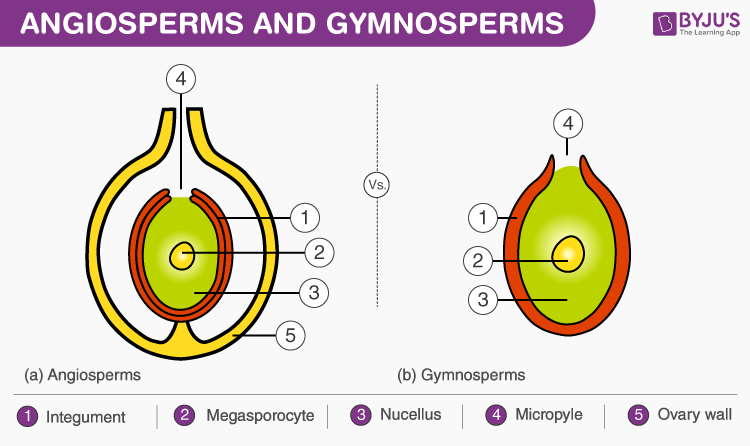What are Angiosperms and Gymnosperms?
Angiosperms and gymnosperms are both seed-bearing plants with a few similarities. This is due to the fact that gymnosperms were present for at least 200 million years before the angiosperms evolved, and they may have shared a common ancestor.
The main difference between angiosperms and gymnosperms is their diversity. The diversity of angiosperms is greater than the gymnosperms. The higher diversity indicated the angiosperms adapted to a wide plethora of terrestrial ecosystems. Another characteristic of angiosperms is the flowers and production of fruits.
Read on to explore the difference between angiosperms and gymnosperms.
Difference between Angiosperms and Gymnosperms
Following are the important difference between angiosperms and gymnosperms:

| Angiosperms | Gymnosperms |
| A seed is produced by flowering plants and is enclosed within an ovary. | A seed is produced by non-flowering plants and is unenclosed or naked. |
| The lifecycle of these plants are seasonal. | These plants are evergreen. |
| It has triploid tissue. | It has haploid tissue. |
| Leaves are flat in shape. | Leaves are scalelike and needle-like in shape. |
| Hardwood type | Softwood type |
| These types of plants rely on animals and wind for reproduction. | These types of plants predominantly rely on wind for reproduction. |
| The reproductive system is present in flowers (unisexual or bisexual). | The reproductive system is present in cones and are unisexual. |
Angiosperms
The word angiosperm is derived from Greek, which translates to a “container.” As the name suggests, angiosperms are vascular plants which bear seeds in fruits or mature ovaries. Angiosperm forms flower that carries reproductive organs and fruits. These plants are more adaptive to the terrestrial habitat and have a very wide distribution, around 250000 species have been identified to date.
Angiosperm Examples
Fruits trees, including mango, apple, banana, peach, cherry, Orange, and Pear, often show flowers before they bear fruits, and the pollination process is generally carried out by agents such as bees.
Grains, including rice, corn, and wheat, are also examples of Angiosperm. In these plants, the pollination process is carried out by the wind. Other examples of Angiosperms include roses, lilies, Broccoli, kale, Petunias, Eggplant, Tomato, Peppers and sugarcanes.
Main Article: Angiosperms
Gymnosperms
Gymnosperms are other types of plants that bear seeds directly on sporophylls without covering. As the name suggests, the gymnosperms are vascular plants of the Kingdom Plantae, which bear naked seeds. There are very fewer species of gymnosperms; a few examples of these plants are cypress, Gnetum, pine, spruce, redwood, ginkgo, cycads, juniper, fir, and Welwitschia.
The main reason for being very fewer species is the lack of protection of seeds. The seeds are naked and unprotected when released. They need to get into the ground quickly to take root, or they will be damaged by animals, weather conditions or any other factors.
Main Article: Gymnosperms
Learn more about the Angiosperms and gymnosperms, examples, the differences between angiosperms and gymnosperms, and other related topics at BYJU’S Biology

Frequently Asked Questions
Why are angiosperms considered “better” than gymnosperms?
Technically, gymnosperms are robust and can survive in a variety of habitats. However, angiosperms have two novel features – fruit and flowers. The fruits aid in dispersing seeds, while the flowers provide protection for the ovule. Hence, angiosperms are considered better than gymnosperms.
What is the reproductive organ in a gymnosperm?
The female reproductive organ in a gymnosperm is the cone, and the male reproductive part is the pollen.

It’s good it’s language is too easy to understand
This website give easy and informative knowledge
Nicely explained.
Really it is a good platform to understand needed thing in too simple language
Nicely explained in Byjus learning program
Nice explanation❤️❤️
Nice explanations